McIntosh MC225 Vintage Tube Amplifier Fully Restored
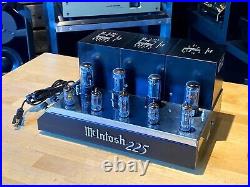
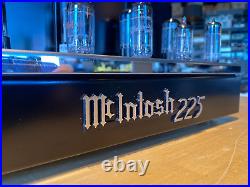
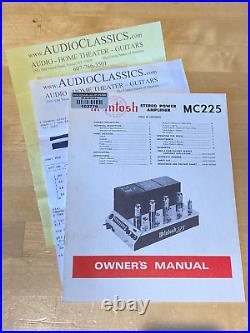
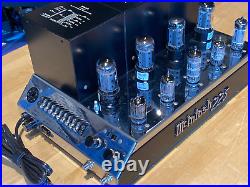
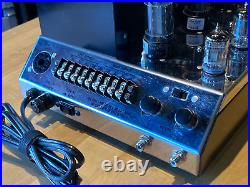
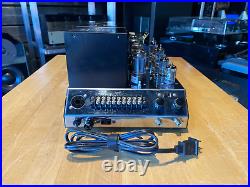
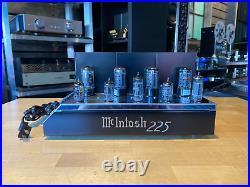
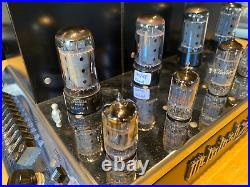
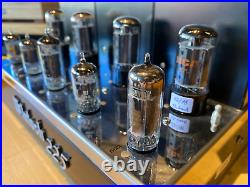
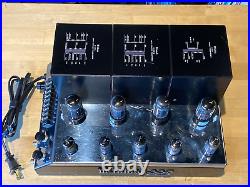
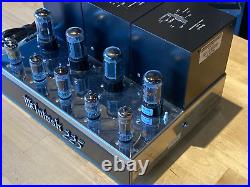
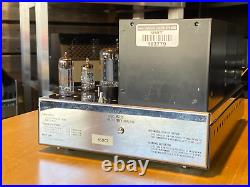
McIntosh MC225 Vintage Tube Amplifier – Fully Restored. SkyFi Audio – Curators of Vintage Audio Gear. No mid-fi, no gimmicks, no junk. Each piece of equipment is cosmetically restored and fully tested in our well-equipped lab by an engineer with 30+ years of experience in the HiFi world. Through our sister company, which is an authorized dealer for McIntosh, Audio Research, Sonus Faber, ClearAudio, Project, and Sony ES, we have access to OEM parts, service, and support. Many audiophiles hail the McIntosh MC225 as the best sounding vintage tube amp from McIntosh ever. Especially if you have high efficiency speakers. We totally agree that if you don’t need the extra 40W or 50W from the MC240 or MC275, then this is your best choice. However, don’t be fooled into thinking an unrestored eBey special will perform to that level. This listing includes the MC225 amplifier, super nice tube cage, the original manual, and the repair receipts as shown in our photos. This amp was restored by the McIntosh experts at Audio Classics in 2005 and has since been in storage. Here are some details about the restoration work performed based on our review of the work itself, along with review of all the Audio Classics receipts. Power supply. All electrolytic cap cans replaced. Bias supply diode replaced. All paper caps replaced with PIO and Panasonic Film. Select resistors replaced in key circuit locations plate load, phase inverter balance, etc. Power cord replaced SkyFi Tube Notes: When this amplifier first arrived into the shop it was fitted with a set of miscellaneous tubes from several different manufacturers. During our initial testing we found that every tube tested strong. On bench testing, the differences did not seem to affect frequency response or channel balance in any measurable way. The SkyFi Testing Process for Tube Amplifiers. We start with a visual inspection of all internal components to make sure that there are no signs of heat stress or damage. Capacitors are checked for telltale signs of predictive failure including bulging, shrunken wrappers, or physical leakage. We also inspect resistors and other passive components for signs of overheating. If tube arcing has occurred in the past we can usually spot discoloration on the output tube sockets. On vintage units we often spot check select capacitors for value and ESR. If the amplifier passes visual inspection, we move on to a full test of all of the tubes. We use an Amplitrex AT-1000 Tube Tester which is capable of testing both emission and Gm with a high degree of accuracy. We document the results of each tube and replace any weak or suspect tubes before proceeding. When we power on tube amplifiers for the first time we usually use a variac and current limited AC supply and slowly raise the voltage up to nominal mains level while monitoring plate, screen, filament, and negative bias supply voltages where applicable. If everything is in order we feed a low level test signal into the amplifier’s input and monitor its output on an oscilloscope across an 8 ohm dummy load. At this point we are just looking to verify basic function and confirm that the output transformers are not damaged. Once we have verified that the amplifier is safe to operate, we connected it to full mains power. For cathode biased amps we monitor the plate to cathode voltage to determine if the output tubes are operating in a safe range. Once the output section is verified we move onto bench evaluation. We start by feeding the input of the amplifier with a low level 1KHz test signal, slowly increase its amplitude while monitoring the amplifier’s output on an oscilloscope for signs of noise, clipping, distortion, or improper channel balance. We continue increasing the signal level until the amplifier reaches clipping. At this point we take an output power measurement and compare it to the spec sheet of the amplifier to verify proper performance. We finish off the bench evaluation with a 1KHz square wave check and a 20Hz to 20KHz sine sweep to assess the amplifier’s frequency response characteristics. This battery of tests will usually reveal if the amplifier has any issues that need further attention. Before the device leaves the bench, we perform a listening test with actual music using a variety of preferred test tracks. Our benches are outfitted with familiar monitor speakers which help us identify inconsistencies that will not always show up on our test gear. The main things that we are listening for are hum or noise with no signal present, proper center image, clicks, pops, or any other obvious undesirable audio characteristics. If the unit passes all of these tests it is moved to our long term testing rig where we simulate real word operating conditions for 6-8 hours. For tube amps we like to run this test at least twice. This allows us to monitor the unit for signs of thermal runaway or intermittent issues that only crop up when it has fully come up to temperature. We find this step to be essential, especially for vintage units. More from the Original McIntosh Owner’s Manual The MC225 has on one chassis two 25 watt power amplifiers. In addition to use as a stereo amplifier, the flexibility of the MC225 permits it to be uséd as a monophonic amplifier that delivers 50 watts, or as two separate 25 watt amplifiers with each channel amplifying completely separate pro- grams, or as two amplifiers for use with an electronic crossover network. Such flexibility permits maximum use for greatest return from your investment. Over one million watts of amplifier output power capacity have been manufactured by Mclntosh since 1947. In this 1,000,000 watts of audio power there are less than 10 watts of distortion capacity and less than 1/100 watt of noise capacity! The dramatic difference in the quality of music reproduction when you listen through Mclntosh instruments is directly due to low distortion performance. Careful, devoted research is a way of life at Mclntosh. The world’s finest amplifier is the creation of per- severing, resourceful Mclntosh engineers. Patent Office has rec- ognized the advanced technology of the Mclntosh circuit by granting 6 patents. Yes – Power Only. If we don’t have the original manufacture’s packaging, we use heavy duty double-ply corrugated boxes with custom made to your item SealedAir Instapak expanding foam custom inserts. In many cases this has proven to be better than the original packaging! We also use high quality fiber reinforced tape to seal our packages. We have too many items for sale and it is nearly impossible to keep track of offers outside of the official system. Please understand we have no control over this. Sorry, our items are NOT available for pick-up. No additional information at this time. You might also like. Monster Cable – M Series Speaker Cable – 8. ReVox B795 Tangential Tracking Semi-Automatic Turntable. Dynavector 10×3 High-Output MC Phono Cartridge. Rotel RHT-10 MICHI Series FM Tuner – Rare. This item is in the category “Consumer Electronics\Vintage Electronics\Vintage Audio & Video\Vintage Amplifiers & Tube Amps”. The seller is “skyfiaudio” and is located in this country: US. This item can be shipped to United States, Canada.
- Brand: McIntosh
- Country/Region of Manufacture: United States
- MPN: MC225
- Model: MC225
Tags: amplifier, fully, mc225, mcintosh, restored, tube, vintage